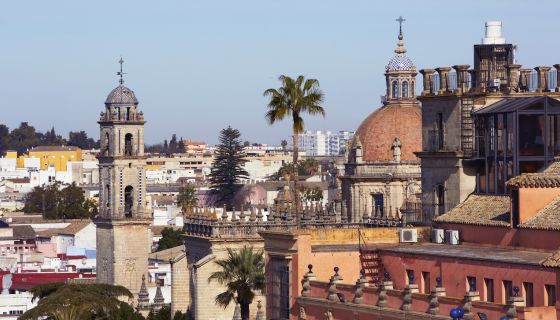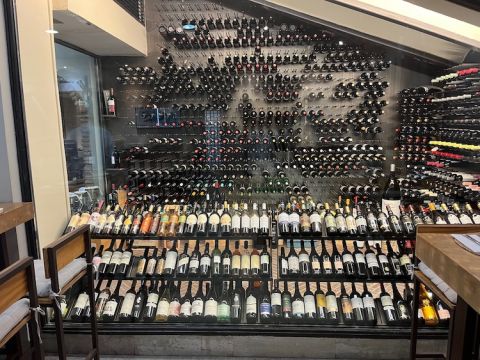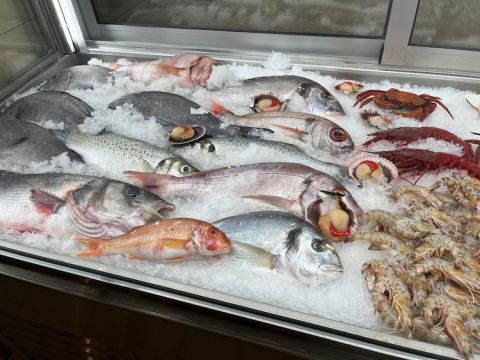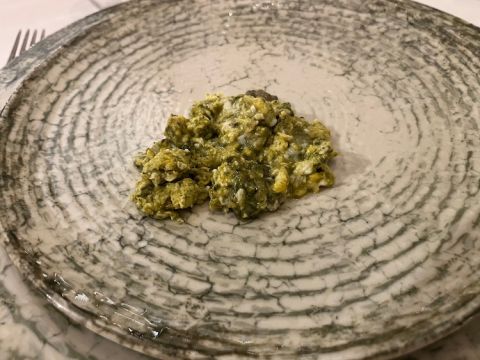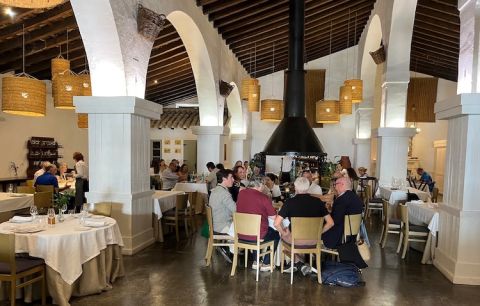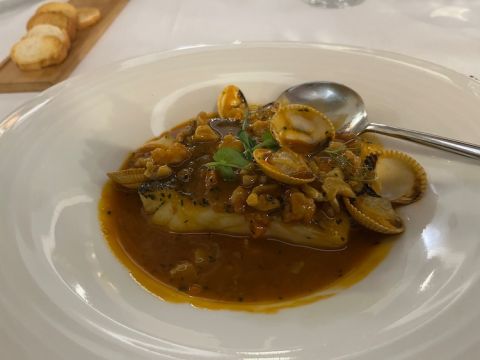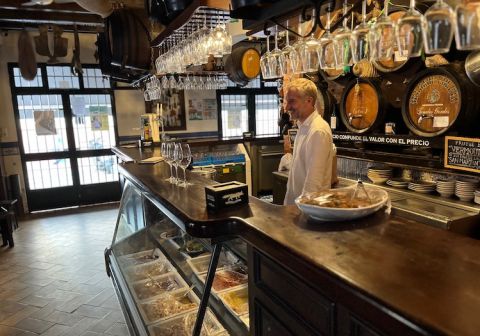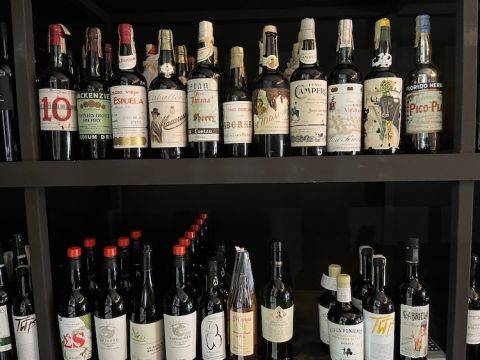When I was last in the sherry town Jerez – 12 years ago, I am ashamed to say – I ended my article by expressing my enthusiasm to return. Better late than never ...
When I finally got there again this week, I found a changed city. The charming, historic city centre has more places to eat and drink than ever, and Jerez seems more buoyant and confident despite the challenge of five continuous years of drought. Tourists have returned. There are far more comfortable hotels. And the Jerezanos seem to have far more disposable income.
As in so many Spanish cities, leaving aside the wine connection for a moment, there seems a comfort, a pride, in the profession of the restaurateur. They seem happy in their skins, and the longer they practice their profession, the happier these individuals become. After all, practice makes perfect.
That was certainly the impression Fermín Anguita gave when we met him at the entrance to his restaurant El Bichero (Spanish for 'fish hook') which he runs with his wife Rocio, a ten-minute drive east of Jerez city centre.
Anguita makes his culinary and wine approach manifestly clear once you have walked past the spacious outside seating area and into the comfortable restaurant. On the right is a large plate-glass window into the restaurant’s wine cellar with its vast range of bottles, almost all local, including a sizeable collection of old Lustau sherries. We were there with two wine producers who urged the staff to fiddle judiciously with the bottles most obviously on show.
Just beyond is another showcase, this time for the day’s fish and shellfish. There were large sea bass, the biggest red mullet I have seen in a long time, bags of razor clams, a loin of tuna, half a dozen of the large red prawns found in the Mediterranean which Spanish chefs love to slice down the middle before grilling, crabs, smaller prawns and scallops. In the bottom right-hand corner was a bucket containing something I had never seen before. Anguita explained they were sea anemones which they cook with scrambled eggs and suggested including them in a menu he would choose for the five of us on that quiet Monday night. (This is one of the few Jerez restaurants that is open on a Monday.)
We enjoyed a comforting meal waited on by two men who looked even older than us but who provided polished, sophisticated but charming service. This allowed the kitchen to show off in a low-key way. First came a thin piece of raw tuna and a thin slice of avocado on a crisp tostada; then slices of tuna matured in olive oil accompanied by slices of raw tomato; then more tuna, grilled on this occasion – partly an excuse for the kitchen to show off its frying prowess as accompanying the tuna was a heap of crisp, thin chips. Next were the sea anemones, scrambled with eggs which made their slightly rubbery, snail-like texture softer (see below).
Then to the ‘main course’, a piece of croaker with pasta, and finally a couple of luscious pastries. With this we drank sherry to begin and ended with a magnificent bottle of Hacienda Monasterio 2015 Ribera del Duero. The bill for the food for the five of us (we brought our own wine) came to just €197.
One aspect of the restaurant business that intrigues me when eating in owner-run establishments such as this is how they evolve. This was what impressed me when I sat down at La Carboná the following lunchtime.
I had been here in 2011 but this time it felt slightly different. It was a Tuesday lunchtime and the chef had decided to open specially because it was the first day of Copa Jerez, a biennial food-and-sherry matching competition. Most of the tables occupied by 3.30 pm were taken by customers carrying the branded Copa Jerez shoulder bag.
Almost all these diners knew my host Ferran Centelles, our Spanish specialist, and he spent much of the meal getting up from the table to hug someone he hadn’t seen for a while. It reminded me of being a young boy in Manchester when I was out with my late grandfather, known by one and all as Uncle Willie and then the most popular man in that city.
La Carboná feels as comfortable as it did back in 2011, comfortable in its skin as an old bodega that has been converted with charm and care. The mirrors are still well polished; the large light fittings still catch the eye; the central open fireplace, unused this lunchtime, is still there. Only the waiting staff have changed. They looked younger, smarter and extremely proud to be wearing their pristine La Carboná aprons.
Javier Muñoz Soto is still in charge of the kitchen. His father and his mother (although she was absent that day) still patrol the area in front of the large bar making sure that everything runs smoothly, that hands are shaken, the odd cheek is kissed and, perhaps most importantly, that everyone leaves their restaurant with a smile on their face planning to return. We most certainly did.
There has been one big change in La Carboná over the years, however. The kitchen has grown even more confident: the dishes that come out of it are cooked with a finesse that only time and experience can deliver. My two savoury dishes were exemplary. I chose a first course of veal sweetbreads finished with a glaze of González Byass’s Alfonso Oloroso that was rich and delicious yet not sickly. And then I enjoyed one of the best dishes of the year so far. It was described as cod with tripe and cabbage, which may not appeal to everyone. It arrived in a bowl: a fillet of cod expertly cooked under a heap of small clams and the cod’s white tripe. It was absolutely delicious: rich, spicy, and its sauce, based on a subtle marriage of tomatoes and herbs, lip-smackingly good.
With this we drank a bottle of Forlong 2022, a local white (for just €23), and a glass of Palo Cortado with our desserts – a very sweet chocolate souffle and a variation on a rice pudding. The bill was €190.95 for three excluding service. La Carboná is not to be missed, especially as its prices remain so reasonable. First courses are €13.50 to €18 and main courses €22 to €23.50.
Finally, to the Manzanilla town Sanlúcar de Barrameda, a 20-minute drive from Jerez, where I was to meet and share some of the enthusiasms of Armando Guerra (below), a man who seems to find time in the day for his job at Barbadillo, his passion for the growing number of local table wines, his two young children, his bar Taberna der Guerrita and his customers. His bar doesn't usually open until 8 pm but he opened it early specially for us.
Guerra inherited this bar from his father seven years ago and his effect can be seen in two different rooms. The first is given over to a wine school which teaches the principles of wine knowledge and appreciation and culminates every May in a wine festival.
The second is a wine shop where Guerra has filled the shelves with a range of the exciting white wines increasingly being produced locally (more on this from Jancis) and bottles of the oldest and rarest sherry he can find. I discovered a bottle of Mackenzie’s Vintner’s Choice on one shelf (this firm has sadly disappeared) next to a bottle of La Espuela sherry whose label claims the bottle was made in 1870, a claim that Guerra promptly maintained was ‘rubbish’.
The addition of Guerra's growing range of white table wines has led to a certain amount of friction between Guerra Junior and Guerra Senior whose passion for Amontillado remains undimmed. Apparently whenever someone comes in looking for a white wine, Guerra Senior tries to deflect them towards a bottle of his beloved sherry.
Big ships in glass bottles on the walls; cabinets full of miniature bottles of every description; and wherever there is space, casks full of sherry are highlights of this very particular bar, as is its food with its emphasis on the locally caught fish and shellfish.
But for Guerra his taberna has a more serious purpose. ‘In Jerez if you want Tio Pepe you go to the González Byass bodega. If you want La Ina you go to the La Ina bodega. For Lustau wines, you go to Lustau. But here we offer a much wider range, not just from many producers but also in its many different styles.’
El Bichero Carretera de Caulina & CA-3107, 11400 Jerez; tel: +34 956 342 986
La Carboná Calle San Francisco de Paula 2, 11401 Jerez; tel: +34 956 347 475
Taberna der Guerrita Calle San Salvador, esquina con Rubiños, 11540 Sanlúcar de Barrameda; tel: +34 856 131 335

